


The Narrabeen group of sedimentary rocks occurs in the Sydney Basin in eastern Australia. This series of rocks was formed in the Triassic Period.



The Narrabeen group of sedimentary rocks occurs in the Sydney Basin in eastern Australia. This series of rocks was formed in the Triassic Period.
It includes various rock types including lithic sandstone, quartz sandstone, siltstones, claystones, conglomerate and shales, some of which have fossils of plants and fish. Partly in these rocks plants, fish and amphibious animals are petrified.
The red and green shales of the Narrabeen Group are water-tight over the sandstone bodies and the shale of Bald Hill, which forms the top layer of the Narrabeen Group, forms a regional water-barrier layer.
Over the Narrabeen Group, the younger stratigraphic formation of Hawkesbury sandstones accumulated.
Above the Narrabeen group is the younger less fertile Hawkesbury sandstone. Below are Permian sedimentary rocks including measures of coal broadly known as the Illawarra Coal Measures.
The Narrabeen group is most famously seen as The Three Sisters in the Blue Mountains. It can also be seen in various places in the Sydney Basin, such as Long Reef near Narrabeen, and at sea level around Broken Bay.
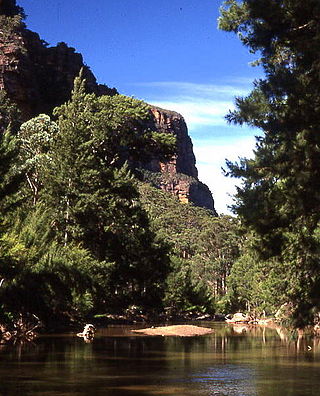
The Wollemi National Park is a protected national park and wilderness area that is located in the Central West and Hunter region of New South Wales, in eastern Australia. The 501,703-hectare (1,239,740-acre) park, the second largest national park in New South Wales, contains the 361,113-hectare (892,330-acre) Wollemi Wilderness – the largest such wilderness area in Australia – and is situated approximately 130 kilometres (81 mi) northwest of Sydney.
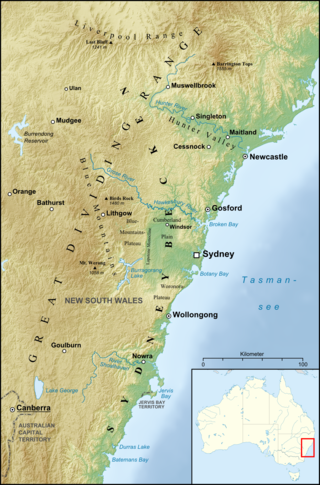
The Sydney Basin is an interim Australian bioregion and is both a structural entity and a depositional area, now preserved on the east coast of New South Wales, Australia and with some of its eastern side now subsided beneath the Tasman Sea. The basin is named for the city of Sydney, on which it is centred.

The Wianamatta Group is a geological feature of the Sydney Basin, New South Wales, Australia that directly overlies the older Hawkesbury sandstone and generally comprise fine grained sedimentary rocks such as shales and laminites as well as less common sandstone units.
Geologically the Australian state of New South Wales consists of seven main regions: Lachlan Fold Belt, the Hunter-Bowen Orogeny or New England Orogen (NEO), the Delamerian Orogeny, the Clarence Moreton Basin, the Great Artesian Basin, the Sydney Basin, and the Murray Basin.
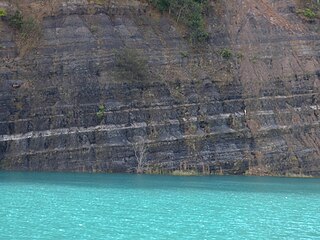
The Clarence Moreton Basin is a Mesozoic sedimentary basin on the easternmost part of the Australian continent. It is located in the far north east of the state of New South Wales around Lismore and Grafton and in the south east corner of Queensland. It is the part of the Great Artesian Basin that extends to the east coast in Australia's central eastern lowlands.

In lithostratigraphy, coal measures are coal-bearing strata, with the term typically applied to European units of the Upper Carboniferous System.

Bringelly Shale is a component of the Wianamatta group of sedimentary rocks in the Sydney Basin of eastern Australia. Formed in the Triassic Period, it has an extensive outcrop in the western parts of Sydney. The shale has its greatest geographical extent at Bringelly, near the suburb of Liverpool.

The Illawarra Coal Measures is a group of sedimentary rocks occurring in the Sydney Basin in eastern Australia. This stratum is up to 150 metres thick. Formed in the Late Permian, it comprises shale, quartz-lithic sandstone, conglomerate rocks, and chert, with sporadically carbonaceous mudstone, coal and seams of torbanite. Coal mining of these measures remains a significant commercial enterprise to the present day. One of the abandoned coal mines in the Blue Mountains is now a tourist attraction.

Minchinbury Sandstone is a component of the Wianammatta Group of sedimentary rocks in the Sydney Basin of eastern Australia.

Bald Hill Claystone is a sedimentary rock found in the Sydney Basin in eastern Australia. It is part of the Clifton sub-group of the Narrabeen Group of sedimentary rocks. It was formed by weathering of the Gerringong Volcanics in the early Triassic. Named after Bald Hill, in the northern Illawarra, where it is 15 metres thick. The claystone is easily noticed at Long Reef, where it is 18 metres thick.

The Garie Formation is a narrow band of sedimentary rocks occurring in the Sydney Basin in eastern Australia. This stratum is up to 8 metres thick, situated below the sandstones of the Newport Formation. Formed in the mid-Triassic, it is part of the Narrabeen Group of sedimentary rocks. Garie formation consists of layers of clay pellet sandstone, dark lithic particles, spotted volcanic deposits and chocolate coloured claystone bands.

Bulgo Sandstone is a sedimentary rock occurring in the Sydney Basin in eastern Australia. This stratum is up to 100 metres thick, formed in the early Triassic (Olenekian). A component of the Narrabeen Group of sedimentary rocks. It consists of layers of fine to medium-grained quartz-lithic sandstone, with lenticular shale interbeds.
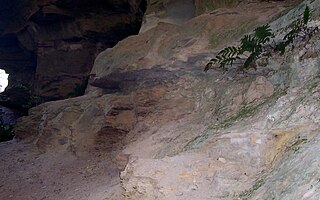
Mount York Claystone is a narrow band of sedimentary rocks occurring in the Sydney Basin in eastern Australia. This stratum is up to 13 metres thick. Mount York Claystone consists of red brown claystones, of fine‐grained and coarsely oolitic, kaolinite clayrocks.

Banks Wall Sandstone is a type of sedimentary rock occurring in the Sydney Basin in eastern Australia. This stratum is up to 115 metres thick. Often seen in the Blue Mountains, such as at the Three Sisters at Katoomba.
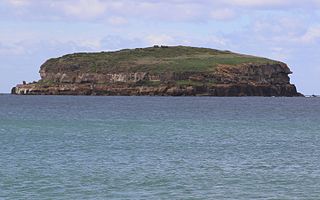
Munmorah Conglomerate is a geologic formation in the Sydney Basin in eastern Australia. This stratum is up to 140 metres thick. Formed in the early-Triassic, it is part of the Narrabeen Group of sedimentary rocks. This formation includes medium to coarse-grained sandstone and conglomerate. With minor amounts of siltstone and claystone. Below the Munmorah Conglomerates are Newcastle Coal Measures, originating from the Permian.

The Terrigal Formation is a geologic formation in the Sydney Basin in eastern Australia. Commonly seen in the Central Coast region, this stratum is up to 330 metres thick. Formed in the early to mid Triassic, it is part of the Narrabeen Group of sedimentary rocks. This formation includes interbedded fine to medium-grained sandstone and siltstone, with minor deposits of claystone. Hawkesbury Sandstone occasionally overlies the Terrigal Formation. Numerous fossils are known from this area, including the temnospondyl amphibian Arenaerpeton supinatus.
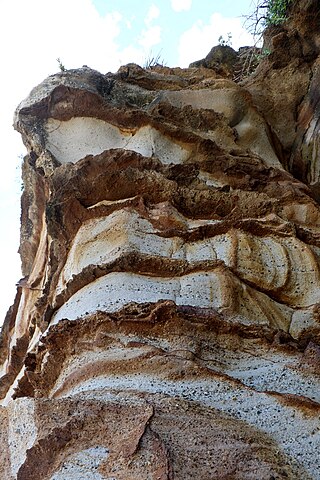
Scarborough Sandstone is a geologic formation in the Sydney Basin in eastern Australia. Commonly seen in the Illawarra region, this stratum is up to 26 metres thick. Formed in the early Triassic, it is part of the Narrabeen Group of sedimentary rocks. This formation includes quartz-lithic sandstone, sometimes with pebbles.

Stanwell Park Claystone is a geologic formation in the Sydney Basin in eastern Australia. Commonly seen in the Illawarra region, this stratum is up to 79 metres thick. Formed in the early Triassic, it is part of the Narrabeen Group of sedimentary rocks.This formation includes red, green and grey shale with quartz-lithic sandstone.
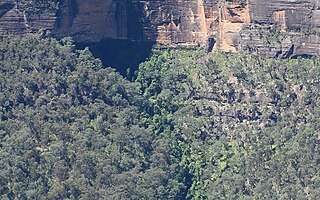
The Caley Formation is a band of sedimentary rocks occurring in the Sydney Basin in eastern Australia. This stratum is up to 46 metres thick. The formation consists of claystone, shale and quartz-lithic sandstone. Often seen situated below the Burra-Moko Head Sandstone in the cliffs of the Blue Mountains.
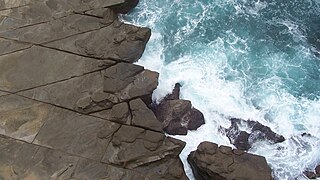
Wombarra Claystone is a geologic formation in the Sydney Basin in eastern Australia. Commonly seen in the Illawarra region, this stratum is up to 30 metres thick. Formed in the late Permian to the early Triassic, it is part of the Narrabeen Group of sedimentary rocks. This formation includes grey shale, and minor quartz-lithic sandstone.